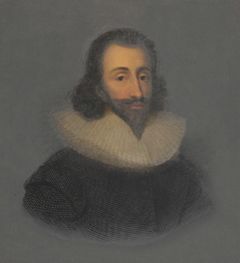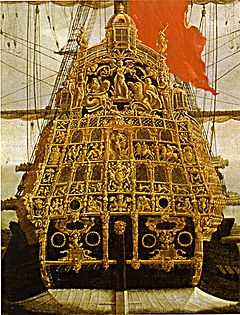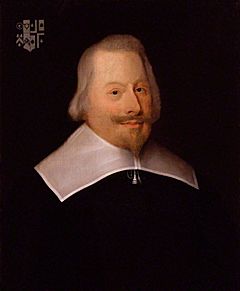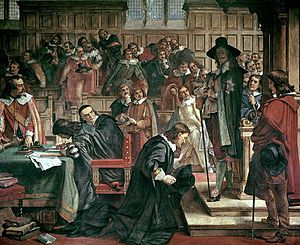John Hampden facts for kids
Quick facts for kids
John Hampden
|
|
|---|---|

John Hampden
|
|
| Committee of Safety | |
| In office July 1642 – June 1643 † |
|
| Member of Parliament for Buckinghamshire |
|
| In office April 1640 – December 1643 † |
|
| Member of Parliament for Wendover |
|
| In office 1624–1629 |
|
| Member of Parliament for Grampound |
|
| In office 1621–1622 |
|
| Personal details | |
| Born | circa June 1595 London |
| Died | 24 June 1643 (aged 48) Thame |
| Cause of death | Died of wounds |
| Resting place | Great Hampden church |
| Nationality | English |
| Spouses | Elizabeth Symeon (1619–1631) Letitia Knollys (1640–1643) |
| Relations | Oliver Cromwell; |
| Children | Ann (1616–1701); Elizabeth (1619–1643); John (1621–1642); William (died 1675); Ruth (1628–1687); Mary (1630–1689); Richard (1631–1695) |
| Parents | William Hampden (1570–1597); Elizabeth Cromwell (1574–1664); |
| Alma mater | Magdalen College, Oxford |
| Occupation | Landowner and politician |
| Signature |  |
| Military service | |
| Allegiance | |
| Branch/service | Infantry |
| Years of service | 1642–43 |
| Rank | Colonel |
| Unit | Hampden’s Regiment of Foot |
| Battles/wars | |
John Hampden (c. June 1595 – 24 June 1643) was an English landowner and politician. He became famous for opposing unfair taxes set by King Charles I. He was a close friend of Parliamentarian leader John Pym and a cousin of Oliver Cromwell. John Hampden was one of the Five Members whose attempted arrest by the King in January 1642 helped start the First English Civil War.
When the war began in August 1642, Hampden formed his own army group. He died from wounds received during the Battle of Chalgrove Field in June 1643. His death was a big loss because he was one of the few people who could unite the different groups within the Parliamentarian side.
Because he died early in the war, Hampden did not see the disagreements that later led to King Charles I being executed in 1649. He also did not see the time when England was ruled without a king, known as The Protectorate. People remembered him as a simple patriot who fought for fairness and democracy. This is why a statue of him was put up in the Palace of Westminster in 1841. He is still remembered each year at the State Opening of Parliament.
Hampden was also popular in North America. Before the American Revolution, leaders like Benjamin Franklin and John Adams used his story to explain why they were fighting for their own freedom.
Contents
Who Was John Hampden?
John Hampden was born around June 1595, likely in London. He was the oldest son of William Hampden and Elizabeth Cromwell. His family had lived in Buckinghamshire for a long time. John's father was a Member of Parliament in 1593. After his father died in 1597, John's cousin managed the family's money. John's younger brother, Richard, inherited other family lands.
Hampden married Elizabeth Symeon in 1619. They had nine children, but only seven lived to be adults. These included Ann, Elizabeth, John, William, Ruth, Mary, and Richard. Richard later became a very important financial official under King William III. After Elizabeth died in 1631, Hampden married Letitia Knollys in 1640. They did not have any children before he died in 1643.
Hampden's Early Political Life (1610-1629)
John Hampden finished his studies at Magdalen College, Oxford in 1610. He then studied law in London from 1613 to 1615. Many gentlemen at the time studied law, not always to become lawyers, but to understand how the country worked. While in London, he met other Puritans. This was a general name for people who wanted to make the Church of England simpler. They wanted to remove what they saw as old-fashioned or "Catholic" practices. Hampden was a Presbyterian, a type of Puritan. He became friends with important Puritan leaders like Lord Saye.

In 1621, Hampden became a MP for Grampound. This was a "rotten borough," meaning it was a small town with very few voters, controlled by a powerful local person. Later, Hampden helped a town called Wendover get its right to have an MP back. He was MP for Wendover until 1629.
In 1626, as MP for Wendover, he was part of the "Useless Parliament." It was called useless because it did not pass any new laws. Parliament wanted to remove the Duke of Buckingham from his powerful position. Buckingham was a close friend of King Charles and known for wasting money.
Instead of agreeing, King Charles closed Parliament. He then tried to raise money by forcing people to give him loans. Over 70 people were jailed for refusing to pay, including Hampden's uncle. When Hampden also refused, he was arrested. In prison, he met Sir John Eliot, another leader who opposed the King. Since the forced loans did not bring in enough money, Charles had to call new elections in 1627. Many MPs who opposed the King were elected, including Hampden, John Pym, and a young Oliver Cromwell.
When the new Parliament met, Hampden worked with Eliot and others to limit the King's power. A key result was the Petition of Right in June 1628. This document aimed to stop the King from raising taxes without Parliament's approval. It also led to another attempt to remove the Duke of Buckingham, who was later killed by an unhappy soldier.
Another issue was two priests, Roger Maynwaring and Robert Sibthorpe. They published speeches supporting the idea that kings had a "divine right" to rule. This meant kings got their power directly from God and could raise taxes as they wished. This angered many, especially Puritans, who believed that only God could decide who was saved. The priests also said that disobeying the King meant risking eternal punishment. King Charles later pardoned these priests. In 1629, Charles closed Parliament and ruled without it for eleven years. This time was known as the "Personal Rule."
The Ship Money Protest (1630-1639)
Hampden was important behind the scenes in the 1628 Parliament. He was good at organizing and working with people. In 1629, he was given land in America, in what is now Old Saybrook, Connecticut. Many Puritan leaders were involved in starting colonies in America. These meetings for colonial companies also gave them a way to plan their political opposition to the King.

Hampden became well-known in 1637 when he was taken to court over "ship money." This was a tax usually collected from coastal areas to pay for the navy, but only during wartime. King Charles was now collecting it every year, even in peacetime. He also made inland counties, like Hampden's home in Buckinghamshire, pay the tax. People opposed this because the King was collecting taxes without Parliament's approval. They were not against a strong navy, but they believed the tax was illegal.
The King also used the money to build a huge warship, HMS Sovereign of the Seas. This ship was five times more expensive than normal ships and too big for most English harbors. Instead of using it to protect England, Charles used it to transport Spanish money and supplies to help Spain fight the Protestant Dutch. He kept the payment for himself.
Hampden and other Parliament leaders owned many properties. To show they only opposed the tax's legality, they paid some of their assessments. Hampden's trial took place in June 1637. The judges were divided, and their decision was delayed until July 1638. Even though seven out of twelve judges said the tax was legal, the fact that five disagreed was a big public relations problem for the King. In 1639, less than 20% of the ship money was actually paid. Many people also refused to pay other taxes, fearing the King would make them permanent.
The Road to Civil War (1640-1642)
After losing the first of the Bishops' Wars against Scotland, King Charles had to call Parliament again in April 1640. This "Short Parliament" refused to approve taxes unless the King made some changes. So, Charles closed it after only three weeks. However, the Scots won again in 1640 and forced the King to agree to harsh terms. This made him call new elections in November.

John Pym became the unofficial leader of the opposition, and Hampden helped coordinate the different groups. Soon after the "Long Parliament" met, it received the "Root and Branch petition." This petition, signed by 15,000 Londoners, demanded that England remove bishops from the Church of England, just like Scotland had done.
People were worried about changes in the Church that seemed too much like Catholic practices. They also saw it as a problem that King Charles was fighting the Protestant Scots but not helping his nephew, Charles Louis, against the Catholic Emperor. Many feared the King would make an alliance with Spain. Ending the King's unfair rule was important for England and for Protestants across Europe.
Since people could not directly attack the King, they went after his "evil advisors." This showed that even if the King was above the law, his helpers were not, and he could not protect them. This made others think twice about working for the King. William Laud, a powerful church leader, was arrested in December 1640. The King's chief minister, the Earl of Strafford, was executed in May 1641.
Parliament also passed new laws to limit the King's power. These included laws that said Parliament had to meet regularly and that the King could not collect taxes without Parliament's approval. However, the bishops in the House of Lords voted together to reject all these new laws. In June 1641, Parliament tried to pass a law to remove bishops from the Lords, but it was also rejected.
The Irish Rebellion started in October, making things even worse. Both the King and Parliament wanted to raise troops to stop the rebellion, but neither trusted the other to control the army.
On December 1, 1641, Parliament presented the "Grand Remonstrance" to King Charles. This was a long list of complaints against his rule. From December 23 to 29, there were many riots in Westminster, led by London apprentices. These riots stopped bishops from attending the House of Lords. On December 30, John Williams, the Archbishop of York, and eleven other bishops complained that any laws passed by the Lords without them were illegal. Parliament said this was an invitation for the King to close Parliament, so all twelve bishops were arrested for treason.

On January 4, King Charles tried to arrest the Five Members, including Hampden, Pym, and Denzil Holles. When this failed, the King left London, along with MPs and Lords who supported him. This was a big mistake because it gave his opponents control of both houses of Parliament. However, even at this point, most people on both sides wanted to avoid a civil war. They asked Parliament and the King to agree to terms.
Hampden and Pym were among the few who understood that only a military victory could make King Charles keep his promises. The King had openly told foreign leaders that any agreements he made were temporary and that he would use force to get his power back if needed. The Irish Catholic rebels claimed the King approved their actions. While this was not true, it seemed believable because the King had tried to use Irish troops against the Scots and had not immediately condemned the rebellion.
In 1642, most people believed that a "well-ordered" monarchy was God's will. The disagreement was about what "well-ordered" meant and who had the final say in church matters. Since the King could not be removed, the only way to deal with him was through military victory. This clear understanding set Hampden, Pym, and later Oliver Cromwell, apart from most others. When the First English Civil War began, Hampden was appointed to the Committee of Safety, a group in charge of Parliament's war efforts.
War and Death (1642-1643)
When the war started in August 1642, both sides thought it would be decided by one big battle. Many areas stayed neutral, waiting to see who would win. Hampden formed his own regiment, which helped protect the cannons at the Battle of Edgehill in October. They also helped push back the King's cavalry. After the terrible Battle of Brentford, Hampden helped gather troops to defend London. However, his most important role was keeping the Parliamentarian groups united during the first winter. He also helped start talks that led to an alliance with the Scots in August 1643.
When the 1643 fighting season began, Hampden was serving with the army led by the Earl of Essex. Many were already worried about Essex's lack of action. Essex was supposed to capture Oxford, the King's war capital. He captured Reading on April 27 but stayed there until mid-May. On June 18, 1643, Hampden was wounded at the Battle of Chalgrove Field. He was shot twice in the shoulder, and the wound became infected.
He died at home six days later and was buried in Great Hampden church. Unlike Pym, who died of cancer later that year, Hampden's death was mourned by both sides of the war. His close friend wrote that England had suffered a great loss. In 1843, a politician named George Nugent-Grenville paid for the Hampden Monument near the battle site.
Hampden's Legacy

John Hampden is often seen as a simpler hero than John Pym or Oliver Cromwell. Because he died in 1643, he did not have to deal with the difficult arguments later in the war. He also did not see the execution of King Charles in 1649 or the time when England was ruled without a king. The poet Thomas Gray wrote about him as a simple person who stood up to unfair power.
In reality, Hampden and Pym both realized earlier than most that King Charles had to be defeated by force. But Hampden rarely gave speeches and was less publicly visible. A historian named Clarendon said Hampden's influence came from his ability to manage people and organize things.
Before the American Revolution in 1774, Benjamin Franklin and John Adams used Hampden's story to show that fighting against the government could still be patriotic. His death in battle also made him a symbol of freedom.
In the early 1800s, a political group in Britain called the Radical movement formed "Hampden Clubs." The poet Percy Bysshe Shelley mentioned him. In Mary Shelley's novel, Frankenstein, Hampden is a symbol of fighting against unfair power. When the Palace of Westminster was rebuilt after a fire in 1834, Hampden was chosen as one of the famous Parliament figures to have a statue there. He is still remembered every year at the State Opening of Parliament.
The Suffragette movement in the early 1900s used Hampden's story to support their slogan "No vote, no tax." Modern groups who refuse to pay taxes also use him as an example. However, Hampden's main point was that taxes should not be collected without Parliament's approval, not that taxes themselves were wrong.
Many places and things are named after him in Britain and other English-speaking countries, especially in the United States. These include Hampden-Sydney College in Virginia, founded in 1775, along with many schools, towns, counties, and hospitals. Mount Hampden was chosen as the location for the new Parliament building in Zimbabwe. One of the London Underground electric locomotives was named "John Hampden." It is now on display in the London Transport Museum. Two Masonic lodges are also named after him.
Several communities in the United States are named after him, such as Hampden County, Massachusetts, Hampden, Massachusetts, and Hamden, Connecticut. There is also Hampden, Newfoundland and Labrador in Canada.
The Handley Page Hampden, a bomber plane from the Second World War, was also named after him.
Sources
| Parliament of England (to 1707) | ||
|---|---|---|
| Preceded by Sir Francis Barnham |
Member of Parliament for Grampound 1621–1622 |
Succeeded by John Mohun Sir Richard Edgecumbe |
| Preceded by Franchise resumed |
Member of Parliament for Wendover 1624–1629 |
Succeeded by Parliament suspended until 1640 |
| Preceded by Parliament suspended since 1629 |
Member of Parliament for Buckinghamshire 1640–1643 |
Succeeded by George Fleetwood |
See also
 In Spanish: John Hampden para niños
In Spanish: John Hampden para niños

